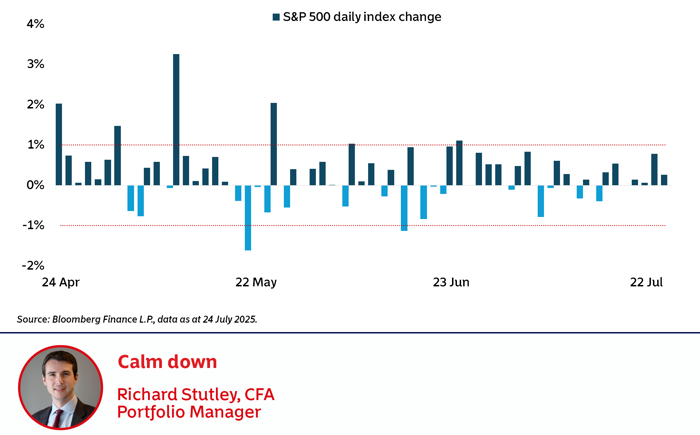
What this chart shows
Credit to Bloomberg for this chart, which neatly illustrates what we’ve all been feeling: namely, that a degree of calm has returned to markets following the tariff induced panic at the start of Q2. The chart shows the daily change in the closing level of the S&P 500 Index over the past three months. The start of the period is characterised by big swings in markets in both directions, but now we appear to have entered a period of calm, with no daily moves greater than 1% in either direction since the 24th of June.
Why this is important
There are good reasons why volatility has reduced recently: progress on trade deals between the US and its trading partners; the related easing of Sino-American tensions; and the rowing back of the most serious threats to remove Fed Chair Powell. All this should serve as a reminder that things tend to work out, particularly when a deal is clearly in everyone’s best interests. As a rule, focus less on what’s being said by policymakers and more on what makes sense in the long run.
There is another way to interpret this chart however, particularly when viewed alongside other data like the decline in the VIX index, a measure of expected volatility. We think it perhaps shows a degree of complacency creeping into markets, despite clear risks on the horizon, not least of all from the change in America’s terms of trade with the rest of the world. Be fearful when others are greedy as the maxim says, hence, while we remain constructive on markets over the medium term, we are also spending time looking over our portfolios to check they are sufficiently diversified to weather what comes next, whatever that may be…
Equity markets surged to new all-time highs in response to strong quarterly earnings, a major US-Japan trade deal, and growing optimism around US trade negotiations with the EU and other partners. These developments drove record performances across indices like the S&P 500, Nasdaq, and FTSE, helping offset concerns around tariffs and economic uncertainty.

-
US stock indices hit record highs mid‑week: Nasdaq and S&P 500 led gains, fuelled by strong Q2 earnings (81 %+ of companies beating) and resilient consumer data.
-
CPI rose 0.3% in June; annual rate climbed to 2.7% (core inflation slightly slower at 2.9% y/y).
-
Retail sales rebounded 0.6% in June, recovering after May’s decline pointing to consumer strength
-
Markets gained after cryptocalm regulatory clarity via Trump’s GENIUS Act, which established stablecoin rules; crypto and Coinbase rallied

-
UK Consumer Price Index unexpectedly rose to 3.6% in June, the highest since January 2024; services inflation held at 4.7%
-
FTSE 100 climbed, aided by a weaker pound, which boosts profitability for FTSE-listed multinationals earning overseas.
-
London-listed companies made waves: Ryanair posted strong profit growth; Assura returned to profit, attracting takeover interest.
-
Market volatility heightened amid fears Trump might fire Fed Chair Powell; yields surged then retreated. Municipal curves flattened.

-
The EU and USA reached a trade agreement on 15% tariff on most of their exports including automotives.
-
The EU agreed to purchase $750 billion in American energy products and invest $600 billion in the US, among other commitments, as part of the pact.
-
Euro area industrial production rebounded in May, outperforming April and bolstering Germany’s investor sentiment to three-year highs.
-
European firms face competing pressures: US tariffs, rising Chinese subsidised imports, and limited ability to retaliate.

-
Markets in China posted modest gains; policymakers see less urgency for further stimulus but monitor risks from deflation and weak retail sales.
-
Broader geopolitical positioning via BRICS summit reaffirmed China’s expanding role in Global South finance and governance reform.
-
Japan’s Upper House election on 20 July saw PM Ishiba’s coalition lose majority; he remains in power but now dependent on minor parties.
-
Commodities diverged: copper prices rose amid trade optimism; metal markets await clarity on impending US tariffs on copper and others. Oil and gold surged temporarily after Iran threatened Strait of Hormuz closure, then stabilized near US$67‑78 bbl as tensions eased.
